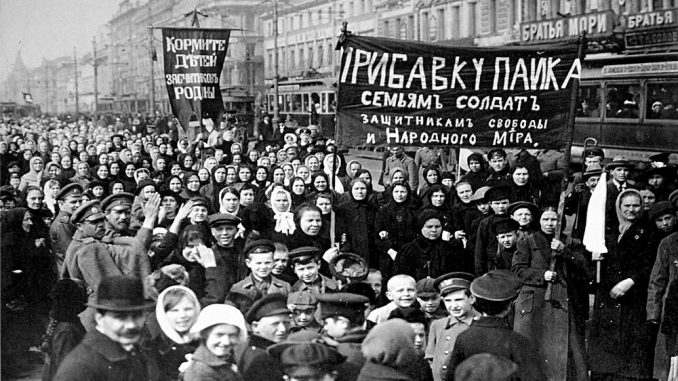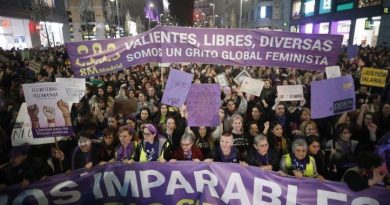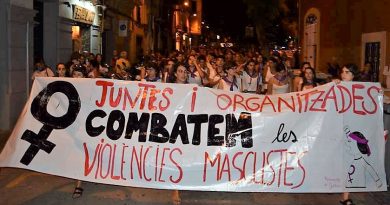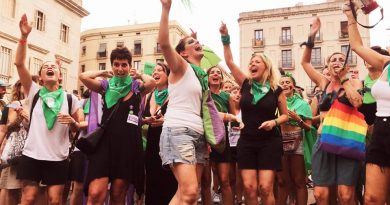The International Women's Day began the Russian Revolution
At the beginning of 1917, Tsarist Russia was a boiler to explode. Intervention in the world war caused more and more suffering.
At the beginning of 1917, Tsarist Russia was a boiler about to explode. Intervention in the world war caused more and more suffering to the working class and the peasantry. He 23 February 1917 (8 March of our calendar1) on International Women's Day, textile workers in the capital declared a strike and marched through the streets of the city. The claim of "Pan" quickly became that of "Down with the Tsar!"The revolution had begun. The following day the strikes and demonstrations multiplied. The strength of the working class swept away with the repression, entire bodies of Cossacks and troops refused to repress ... the die was cast. He 27 February the Tsar finally fell. A spontaneous revolution, without centralized steering, although he counted on his vanguard with the educated workers in Bolshevism. Power was in the hands of the worker and peasant masses, but their recognized addresses, Mensheviks and Social Revolutionaries (SR), they handed it over to the bourgeoisie. For their leaders, the task set was to build a bourgeois republic to develop capitalism. The Bolshevik Party, from the arrival of Lenin, drew another line: no confidence in the bourgeois government. All power to the soviets. October Prologue
Maybe you are interested: #8M2020 / Statement LIS: Neither chauvinism nor capitalism: equality and socialism
Parallel to the emergence of provisional government another power emerged. Los soviets (tips) of workers, soldiers and peasants who multiplied throughout the country reflected a new power based on the strength of the mobilized masses. Most of its delegates responded to Mensheviks and SR, that they supported and would later integrate the government bourgeois. The provisional government supported by the reformists did not solve none of the urgent demands, maintained the war and postponed the delivery of lands to the peasants until the holding of a Constituent Assembly that permanently postponed. They were months of a rapid experience of the masses with their addresses. In October, eight months after the start of the revolution, the Bolsheviks obtained most of the main soviets and directed the workers and peasant forces towards the seizure of power, giving rise to first workers state in history.
The differences between February and October
Comparing both revolutions, Trotsky argued that, in relation to the disputed classes, the field of struggle and the role of the army (that is passed next to the revolution), February and October they are identical. The difference, qualitative, which makes it possible for you to work and peasants take power in October is the relevant role of the soviets and the Bolshevik Party leadership. In history there has been no repetition revolution with those characteristics. Although there were great triumphs, not being led by the working class and a revolutionary Marxist party, has not spread the world revolution and that has even led to the loss of conquests that had been obtained and to not finish defeating the imperialism. Nevertheless, the crisis of the capitalist system, their policies permanent adjustment, and the hardships it unleashes on the masses accumulate tensions that often explode producing true revolutions that cause qualitative changes even though they do not change the class character of the State. At these revolutions, they are not headed by the working class with their democratic self-determination bodies neither by a direction revolutionary, our current defines them as February Revolutions, making an analogy with the process of the Russian Revolution.2
The February-October dialectic
Analyze the February revolution not only from the historical point of view, but in its dynamics, is key to understand the dialectic with October and remove from there the tasks of the revolutionaries. “(…) The most indisputable characteristic feature of revolutions is the direct intervention of the masses in events historical (…) The history of revolutions is for us, above of everything, the history of the violent irruption of the masses into the government of their own destinies ”. 3 The mass mobilizations that brought down the dictatorship, the Argentinazo, the arab springs, and what is happening in Chile are for us February revolutions. There are those who question this definition because this would imply that necessarily later would come October and in all these cases, as in others, this has not happened. But just because there is no progress towards October is that the underlying problems are not they solve. Some sectors, from that analysis, seeing that I don't know produce new octubres, they abandon the revolutionary fight adapting to the bourgeois regime as its "left wing". Other sectors directly deny that are revolutions because they would not aim to change the existing order, because they only demand partial claims, for the immaturity of the masses to consider their historical objectives or arguments like that.
Consciousness and revolution
The advance in the consciousness of masses is not an evolutionary process. In normal times, the dominant ideology is the one imposed by the bourgeoisie and has its expression in the majority control of workers and popular organizations by bureaucratic leaderships and reformists. February is the prologue to October precisely because it is from she who opens the possibility for the masses to make the experience thoroughly with those directions, and if there is a party that disputes with a policy correct and bold, it is possible to make qualitative advances. Wait for the masses acquire by themselves revolutionary consciousness is to separate oneself from the responsibilities posed by these processes and becomes in fact in a abstentionist policy. "The masses do not go to the revolution with a plan preconceived of the new society, but with a clear feeling of inability to continue supporting old society. Only the leading sector each class has a political program, program that, Nevertheless, needs to still be subjected to the test of events and to the approval of the masses. ”4 We said that in February and October the slogans were the same: Paz, Bread and Earth. The difference was that the masses for months made a experience with your directions, that they did not solve any of their demands, and they contrasted it with the politics of the Bolshevik Party. The qualitative leap in consciousness it was not the fruit of a gradual evolution, but of a battle politics between revolutionaries and reformers. The Bolshevik Party, Besides, he incorporated into his ranks the current led by Trotsky (with whom Lenin argued harshly during 12 years) and at key moments made an agreement with the left social revolutionaries for the seizure of power. The phase current class struggle, of capitalist crisis and at the same time, of a great rise of the mass movement that is strongly expressed in Latin America, Middle East and France we poses the challenge of intervening in these processes to set up a revolutionary leadership that lives up to the circumstances, battling against the old and new reformers, fighting to develop organisms workers and popular power and uniting the revolutionaries to grow in influence and advance in the perspective of new October revolutions. On this path is the International League Socialist.
Notes 1. Until 1918 in Russia the old Julian calendar was used. 2. We refer to the current founded by Nahuel Moreno, of which we claim part. 3. Leon Trotsky "History of the Russian Revolution". 4. Idem.
By Emilio Poly




